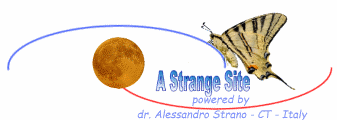IDENTIFICATION OF AMPHIBIANS AND REPTILES
Introduction
Amphibians and Reptiles are two classes of the phylum Chordata; all species shown in this phylum have, at least in one stage of their development, a dorsal chord (a semi-rigid elastic lamina sustaining their body). Amphibians and Reptiles have no regulation system of their body temperature. Their temperature varies according to the environment temperature. They go into hibernation.
AMPHIBIANS - AMPHIBIA
Amphibian larvae live in aquatic environments and respiration is branchial, while adults are prevalently terrestrial and respiration is pulmonary and cutaneous; the name of this order derives from the Greek language and it means "living in both elements (water and ground)". Therefore, Amphibians are subject to a deep metamorphosis process. Genereally adults have four legs (species of Apoda order have no legs, and species in Sirenidae have only the fore legs), of which hind legs are strong and suited for jumping and swimming. Their body is viscid. Most of them are oviparous and eggs are laid in aquatic environments. These animals are very strong and have an extraordinary capacity to regenerate parts of their body. Generally, adults are carnivorous.
Here it is a list of the most common orders of Italian amphibians and reptiles. The name of orders is the Latin one and, when available, there is also the link to the photos.
Anura order
Adults have no tail; the name derives from the Greek language and it means "without a tail". Some of the commonest families are: Bufonidae (plump, craggy body generally covered with warts, paratoid glands enlarged and prominent in the back of head), Discoglossidae (plump body, discoidal tongue), Hylidae (long legs, flat body, toes with rounded disks at apex), Ranidae (long legs, slender body).
Urodela order
Adults have a tail; the name derives from the Greek language and it means "with a tail". Some of common families are (distinctive features aren't always visible in photos): Salamandridae, Plethodontidae (lungless), Proetidae (external gills even in adults).
REPTILES - REPTILIA
Reptile body is covered with corneous scales and or osseous scales. Generally they walk shuffling their body on the surface (the name derives from the Latin language and it means "crawling"). Most of them are carnivorous. Respiration is pulmonary.
Here it is a list of the most common orders/suborders of Italian amphibians and reptiles. The name of orders/suborders is the Latin one and, when available, there is also the link to the photos.
Testudines order
Body of these animals is covered with plates fused into a kind of shield (shell). There are aquatic and terrestrial species. Some of the commonest families are Emydidae (shell is flat), Testudinidae (shell is high).
Squamata order - Sauria suborder
Sauria, commonly lizards, have a long body and generally 4 legs with 5 fingers (some species have very short legs or no legs). Many species have an extraordinary capacity to regenerate their tail. During their life they have many moults. They feed on insects and other invertebrates. Some of the main families are: Gekkonidae (big eyes fused with transparent eyelids, vertical pupils), Lacertidae (rounded pupils), Scincidae (cylindrical body with small, shiny scales).
Squamata order - Ophidia suborder
Ophidia, commonly snakes, have a cilindric body very long and covered whit scales, they have no legs; a rigorous classification is based on internal morphological elements. During their life they have many moults. Some species have two teeth connected with venomous glands, fortunately in Italy only Vipers (Viperidae) are venomous; unlike other snakes Vipers are ovoviviparous. The Italian snake families are two: Colubridae (rounded pupils, oval head) and Viperidae (vertical pupils, triangular head).

